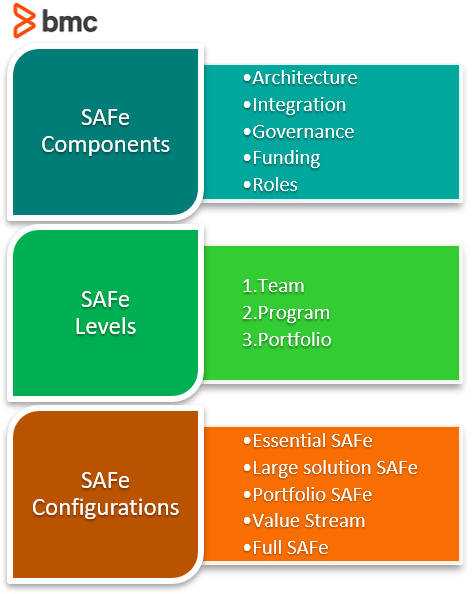If you are working in enterprise IT delivery, chances are you are either utilizing SAFe® or actively considering it as a framework that will help to scale Agile across the enterprise.
SAFe is employed by a large number of the world’s largest organizations for three proven reasons:
- SAFe sustains and drives faster time-to-market.
- SAFe dramatically increases quality and productivity.
- SAFe increases engagement for staff involved in IT delivery.
Let’s take an in-depth look at SAFe, including:
- SAFe components and levels (Team, program, and portfolio)
- SAFe configurations
- Benefits of SAFe
- Who’s best suited for SAFe
- Tips for getting started
- Popular SAFe certifications

What is SAFe?
Short for Scaled Agile Framework, SAFe is a foundational platform that allows Agile to be scalable for enterprise systems and software. It offers the same benefit to companies as Scrum does to Agile teams. A primary goal for SAFe is to align development to further business objectives.
SAFe combines learnings from proven agile methodologies to create a platform that meets the requirements for software development within large enterprise programs. Like Scrum, SAFe offers a flexible, evolving framework in which incremental milestones are met to complete a larger project. The popularity of SAFe is driven by its structured and methodical approach to project alignment and completion.
Based on Agile principles, SAFe has five main components:
- Architecture
- Integration
- Governance
- Funding
- Roles
These components are considered in three different levels:
- Team
- Program
- Portfolio
Let’s look at each of these levels.
Team considerations
SAFe employs multiple teams in order to scale to meet enterprise requirements. Teams will work both independently and in collaboration with other teams. Regardless of the duties each team is assigned, every team is agile in nature.
As in other agile ways, each team will consist of 5-9 members working toward a specific programming goal. A systems team, also known as a design-build-test (or D/B/T) team, is responsible for testing and delivering software once every two weeks. These two-week periods are referred to as sprints.
There are two key differences when comparing SAFe to other agile methodologies:
- The teams work interdependently with each other.
- Their sprints can occur concurrently.
A unique facet of SAFe is the creation of a perceived rhythm that synchronizes all team progress. The objective is to promote reliability—not variability—in the team programming environment.
Program considerations
An agile release train (ART) will typically consist of 3-5 teams working in sync on a single software development for a program iteration (PI). The PI is the larger unit of measurement within the program. The agile release train is the primary means of delivering value during a PI.
A single sprint will have one team producing one piece of the software puzzle, as the PI contains multiple teams completing their sprints at the same time. All development created during the PI is subject to the innovation and planning iteration (IP), which occurs at the end of the PI.
During the IP, you will:
- Test and demonstrate all development from the PI.
- Examine the results in detail during an inspect and adapt session. During this session developers will research and identify improvements and causal dependencies.
The program level has multiple roles:
- System team
- Product manager
- System architect
- Release train engineer (RTE)
- UX and shared resources
- Release management team
Let’s have a close look at the responsibilities of some of these roles.
Product manager
The product manager is responsible for external facing interactions and work. It is their job to:
- Speak to customers
- Define the requirements and scope of the products being built
- Communicate requirements and needs to the product owners.
System architect
The system architect will communicate:
- The technical path through the architectural runway
- Non-functional requirements (NFRs)
- The design and support of the continuous delivery pipeline
Release train engineer
The release train engineer (RTE) is a servant leader and coach for the agile release train. The responsibilities of the RTE are to:
- Facilitate ART events and processes
- Assist teams to deliver value
- Communicate with stakeholders
- Escalate issues
- Assist in managing risk
- Drive improvement
UX Designer
The UX designer is responsible for providing design elements to the agile teams. These elements make up the user interface of the enterprise agile framework and will dictate the overall user experience of the software.
Release management team
In the past, the release manager would focus on planning, development and testing phases. In the SAFe world, this role is concerned with the operations side of the coin—for example, building an automated pipeline and process that ensure code can be safely propagated to production.
Today’s release management team needs to interface with operations, customer success, support, sales, product management and marketing functions rather than just with development and QA.
Portfolio considerations
The third level of the SAFe framework is the portfolio. The portfolio is a collection of multiple value streams, connected to the overall enterprise software via themes like:
- Strategy
- Investment funding
- Program management
- Governance
Each of these themes will contribute to overall budget planning for a period of 6-12 months. Large development initiatives, or epics, will span across agile release trains and assist in defining the development need to realize the identified themes.
Business epics are customer facing, while architectural epics are technology solutions and are not visible to customers. These types of epics are managed in a Kanban system.
SAFe configurations
Your organization can opt for one of several SAFe considerations to implement. The configuration that is chosen will depend upon:
- Your industry type
- The maturity of your organization
- Additional factors
The different configurations are described here:
Essential SAFe
Essential SAFe is the basic configuration. Many businesses starting out with SAFe choose this configuration because it focuses on the most critical elements needed for success. It includes a foundation, with team and program levels.
Large solution SAFe
For industries that specialize in large, complex systems, but do not require considerations at the portfolio level—like government and defense—large solution SAFe may be the appropriate choice. This is the same as essential SAFe with a large solutions level added in place of the portfolio level.
At the large solutions level, a solution train ensures value delivery of even the most complicated, large-scale systems.
Portfolio SAFe
This is the most common iteration of SAFe, often simply referred to as SAFe. Portfolio SAFe operates the structure described earlier. It contains all three levels—team, program, and portfolio-level requirements. During the portfolio phase, you’ll define budgets with the help of epics and themes.
Value stream: the 4th level
An additional value stream layer can be added to the SAFe framework between program and portfolio levels. This is most applicable during large system developments, but it can be applied to any enterprise system.
A value stream is defined as the series of steps it takes to deliver value from the beginning of development right through to customer interaction. The flow is usually initiated by a customer request or requirement and ends with delivery.
Full SAFe
This configuration of SAFE includes all components of the SAFe configurations we have looked at already. This is for very sophisticated, large systems that could take thousands of people in hundreds of teams to develop. This comprises team, project, portfolio and large solutions and makes room for value streams throughout the journey.
Benefits of the Scaled Agile Framework
Some benefits of using SAFe as your enterprise solution include:
- Its regimented structure
- Clear definitions and boundaries
- Flexibility
- Overall ability to scale with program needs
- Multiple configurations
- The ability to (finally) get all teams in alignment on a single project
Finally, there are a wealth of educational resources supporting the use and adoption of SAFe, including tools and certifications.
Who is SAFe for?
If you need to scale your development platform for large-scale enterprise solutions, then SAFe may well be the right iteration of Agile for your business. But, there is much to consider. As with any major change in the way you work, the cultural side of a movement to SAFe will need to be carefully managed. You’ll need to find champions, gain effective executive support, and keep the communications channels open—both ways.
In a large organization, you will probably find that your development teams will already be using versions of agile to meet their goals, but by bringing these together under the umbrella of SAFe you will be able to improve the quality you deliver to your end users.
The SAFe framework, based on the principles of Agile, provides a familiar system for developers who are used to Scrum and sprints, with the same level of reliability to provide consistent results.
This makes it an excellent choice for developers who want to branch out into enterprise solutions, or for any organization that needs to restructure their development framework and processes.
Some indications that you might be ready for an enterprise adoption of SAFe:
- You successfully use agile at the team level.
- You have multiple teams running their own agile adaptations, but without consistency.
- You want to use agile across the organization, but you lack the structure that SAFe provides to define management roles.
- You have implemented an agile approach but have not achieved consistency and alignment.
- Product development lead times are a pain point for the organization.
Getting started with SAFe
Identifying a value stream that produces consistent results across the board is essential to the adoption of SAFe in an organization. To identify a value stream, you should consider the following questions:
- Who is supporting this idea?
- Which executives are ready for change?
- Where are potential team members physically located?
- How are team members distributed?
It is important to understand that you don’t just ‘dip your toe in the water’ in SAFe. Once you have identified the best approach to take, you must be ‘all-in’. It is a full adoption—or nothing at all.
SAFe certification and training
SAFe certification is a valuable commodity in today’s competitive employment market. There are several certifications available for anyone wanting to learn more and to demonstrate their knowledge of SAFe. Common benefits of certifying include:
- Demonstrate your skills and experience
- Stand out among the crowd
- Increase your value (and command higher pay)
- Keep your knowledge up to date
The available certifications cover all levels of experience. The list below is covers some of the certifications that are provided by Scaled Agile, Inc. the official certifying body for SAFe. A full list of qualifications can be found at ScaledAgile.com.
SAFe Agilist (SA)
A certified SAFe agilest (SA) strategically guides the adoption, success and ongoing improvement of lean-agile culture in an enterprise. They key areas of competency for the SA are:
- Apply SAFe to scale lean and agile development in the enterprise
- Apply lean-agile mindset and principles
- Plan and successfully execute program increments
- Execute and release value through agile release trains
- Build an agile portfolio with lean-agile budgeting
Who’s it for: The certification is recommended for CEOs, program or project managers, scrum masters, team leads, release train engineers, business analysts, agile coaches, CIOs, portfolio managers, consultants, engineers, change agents, and solution or systems architects.
SAFe Practitioner
A certified SAFe practitioner is responsible for using Scrum, Kanban, and Extreme programming (XP) in a SAFe environment. The practitioner is responsible for planning program increments and iterations, breaking requirements into stories, developing incrementally, demonstrating value, and problem solving.
The key competencies for the SAFe practitioner are:
- Explain SAFe agile principles
- Plan iterations
- Plan program increments
- Execute iterations and demonstrate value
- Improve agile release train processes
- Integrate and work with other teams on the ART
- Perform as a member of an agile team on an ART
Who’s it for: This certification is recommended for program or project managers, scrum masters, team leads, release train engineers, business analysts, agile coaches, consultant architects, engineers, developers, directors, product managers, product owners, program managers, change agents, operations staffs, and programmers.
SAFe Scrum Master
The SAFe Scrum Master is responsible for integrating Scrum practices into an organization. The key competencies for the Scrum master are:
- Using Scrum and Kanban to facilitate team events
- Supporting program execution
- Coaching agile teams
Who’s it for: This certification is extended by the advanced Scrum Master certification.
This certification is recommended for program or project managers, scrum masters, team leads, release train engineers, business analysts, agile coaches, portfolio managers, consultants, architects, engineers, developers, directors, product managers, product owners, and delivery managers.
SAFe Product Owner/Product Manager
A certified SAFe Product Owner/Product Manager works with customers and development organizations to identify and prioritize requirements.
The key competencies for this role are:
- Apply lean-agile mindset and SAFe principles and practices
- Identify customer needs
- Write epics, capabilities, features and stories
- Prioritize work to deliver value to the enterprise
Who’s it for: This certification is recommended for program or project managers, scrum masters, release train engineers, business analysts, agile coaches, SAFe program consultants, development managers, product owners, product managers, architects, and consultants.
SAFe Program Consultant
The certified SAFe program consultant is a change agent who leads all levels of an organizations through a Lean-Agile transformation by training, coaching, facilitating and mentoring. This servant-leader plays a critical role by applying expert knowledge of SAFe.
The key competencies for this role are:
- Design a SAFe implementation
- Develop an enterprise transformation plan
- Launch and facilitate an ART
- Extend the lean-agile portfolio by launching additional ARTs
- Assist an organization with change management practices
- Train and coach an enterprise through a SAFe transformation.
Who’s it for: This certification is recommended for program or project managers, scrum masters, release train engineers, business analysts, agile coaches, development managers, consultants, directors, product managers, product owners, agile change agents, and software engineers.
A SAFe Solution for your organization
SAFe is an effective way to achieve true agility in development—across the enterprise.
Additional resources
For more on this and related topics, explore these resources:
- BMC DevOps Blog
- BMC Business of IT Blog
- DevOps Guide, with 30+ articles
- Top Agile Certifications of 2020
- Bring the Mainframe into your Agile Development Process
These postings are my own and do not necessarily represent BMC's position, strategies, or opinion.
See an error or have a suggestion? Please let us know by emailing [email protected].






